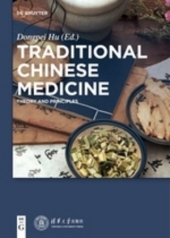 Neuerscheinungen 2017Stand: 2020-02-01 |
Schnellsuche
ISBN/Stichwort/Autor
|
Herderstraße 10
10625 Berlin
Tel.: 030 315 714 16
Fax 030 315 714 14
info@buchspektrum.de |

Dongpei Hu, Tsinghua University Press
(Beteiligte)
Traditional Chinese Medicine
Theory and Principles
Herausgegeben von Hu, Dongpei; Mitarbeit: Tsinghua University Press
2017. 190 S. 170 x 240 mm
Verlag/Jahr: DE GRUYTER 2017
ISBN: 3-11-057992-8 (3110579928)
Neue ISBN: 978-3-11-057992-5 (9783110579925)
Preis und Lieferzeit: Bitte klicken
Derived from ancient Chinese philosophy, Traditional Chinese Medicine is considered to be difficult to understand. This book provides an overview of Traditional Chinese Medicine by illustrating the topics of visceral manifestation, etiology and pathology in a clear manner to readers. Clinical treatments are included to serve as references for practice. This book is well-suited for both researchers and practitioners.
Table of content:
Chapter 1 Introduction
1.1 The discipline nature and properties in traditional Chinese Medicine
1.1.1 TCM is characterized by its natural science nature
1.1.2 TCM has the characteristics of social science
1.1.3 The mutual influences between TCM and ancient Chinese philosophy
1.1.4 TCM is a product of the multidisciplinary interactions
1.2 The main characteristics of TCM theory
1.2.1 Concept of holism
1.2.2 Differential diagnosis and treatment
Chapter 2 The Philosophical Basis of Traditional Chinese Medicine
2.1 Theory of yin and yang
2.1.1 The basic concept of yin and yang
2.1.2 The basic contents of yin and yang theory
2.1.3 The applicable examples in TCM of the yin and yang theory
2.2 Five elements theory
2.2.1 Fundamental concepts and characters of the five elements
2.2.2 The classification of the five elements
2.2.3 The cycle of generation, restriction, over-restriction and counter-restriction in five elements
2.2.4 The application of five elements theory in TCM
Chapter 3 Visceral Manifestation
3.1 Summarization of visceral manifestations
3.2 Five zang-organs
3.2.1 Heart
3.2.2 Lung
3.2.3 Spleen
3.2.4 Liver
3.2.5 Kidney
3.3 Six fu-organs
3.3.1 Gallbladder
3.3.2 Stomach
3.3.3 Small intestine
3.3.4 Large intestine
3.3.5 Urinary bladder
3.3.6 Triple-jiao
3.4 Extraordinary fu-organs
3.4.1 Brain
3.4.2 Uterus
3.5 The relationships among the zang and fu organs
3.5.1 The relationships among the six fu-organs
3.5.2 The relationship between the five zang-organs and six fu-organs
Chapter 4 The Theory of Qi, Blood and Body Fluids
4.1 Qi
4.1.1 Concept of qi
4.1.2 Production of qi
4.1.3 Movement of qi
4.1.4 Functions of qi
4.1.5 Classification of qi
4.2 Blood
4.2.1 Concept of blood
4.2.2 Production of blood
4.2.3 Functions of blood
4.2.4 Blood circulation
4.3 Body fluids
4.3.1 Concept of body fluids
4.3.2 Metabolism of body fluids
4.3.3 Function of body fluids
4.4 The relationships among qi, blood and body fluids
4.4.1 The relationship between qi and blood
4.4.2 The relationship between qi and body fluids
4.4.3 The relationship between blood and body fluids
Chapter 5 Theory of Meridians and Collaterals
5.1 Overview of the theory of the meridians and collaterals
5.1.1 The concept of the meridians and collaterals
5.1.2 Composition of the meridian
5.2 Twelve meridians
5.2.1 Nomination of twelve meridians
5.2.2 Route and connection of the twelve meridians
5.2.3 Distribution of the twelve meridians
5.2.4 Exterior& interior relationship
5.2.5 Circulating sequence of the twelve meridians
5.2.6 Travelling routes of the twelve meridians
5.3 Eight extra meridians
5.3.1 Concept and functions of eight extra meridians
5.3.2 Distribution and physiological functions of the eight extra meridians
5.4 P ysiological functions and applications of the meridians
5.4.1 Physiological functions of the meridian
5.4.2 Application of the theory of the meridian
Chapter 6 Constitutional Theory
6.1 Concept of constitutional theory
6.1.1 Basic concept of constitution
6.1.2 Signs and characteristics of constitution
6.2 Factors affecting constitution
6.2.1 Relationship of the constitution to viscera, meridians, essence, qi, blood and body fluids
6.2.2 Factors which affect the constitution
6.3 Classification of constitution
6.3.1 Balance constitution
6.3.2 Yang-inclinedconstitution
6.3.3 Yin-inclinedconstitution
6.4 Application of the constitution theory
6.4.1 Explanation of the susceptibility of individual to certain pathogens
6.4.2 Illustrating the etiology
6.4.3 Explaining the pathological changes
6.4.4 Guiding syndrome differentiation
6.4.5 Guiding treatment
6.4.6 Guiding the health maintenance
Chapter 7 Onset of Disease
7.1 Concept of pathogenesis
7.2 Cardinal principle of disease onset
7.2.1 Deficiency of vital qi is the intrinsic factor for the pathogenesis
7.2.2 Pathogenic qi is an important factor to cause the disease
7.2.3 Struggle between pat


